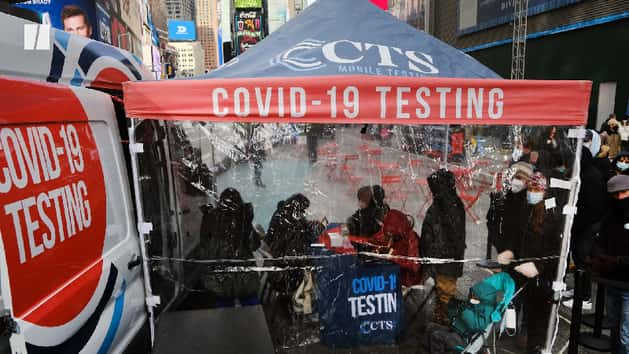Why does December 2021 feel so much like March 2020?
That was the fateful month when the World Health Organization officially declared the novel coronavirus a pandemic. The NBA shut down, and former president Donald Trump banned travel from much of Europe. Offices scrambled to send their employees home and parents tried to navigate child care while schools shut down. Essential workers braced for the worst.
Since then, we’ve learned of the efficacy of masks and social distancing. Vaccines and boosters are widely available, as are treatments. And there’s even a new administration.
“We are looking at a winter of severe illness and death for the unvaccinated — for themselves, their families and the hospitals they’ll soon overwhelm,” President Joe Biden recently said at a White House press briefing. “But there’s good news: If you’re vaccinated and you have your booster shot, you’re protected from severe illness and death.”
While this statement may be true, it’s simply the liberal version of treating a pandemic as a personal responsibility rather than a collective one.
Where is the national testing strategy and contact tracing? Where is the push for economic aid to the industries and workers that remain hard hit? Telling off anti-vaxxers may be cathartic, but it’s not exactly a national public health strategy. Almost two years into the pandemic, a federally led collective response is still woefully lacking.
The shortcomings of our national plan are exemplified by the Centers for Disease Control and Prevention’s new recommendation that infected people can shorten their quarantine time from 10 days to five if they are asymptomatic.
Yes, science evolves. But it’s hard to believe the agency’s decision was based solely on science when the recommendation was also accompanied by an acknowledgment that too many workers in quarantine could hurt businesses.
“We want to make sure there is a mechanism by which we can safely continue to keep society functioning while following the science,” CDC director Rochelle Walensky said. So, is it about stopping the spread ... or getting people back to work?
Shortening quarantine times while the country smashes previous infection records is enough to give even the most well-informed people whiplash.
The ensuing confusion over the new recommendation brought to light just how little confidence the American public has in the nation’s top public health agency; not a great sign for a president who promised a “robust” federal health response.
When Trump left office, the official COVID death toll hit 400,000. Nearly one year later, the grim number is at more than 815,000. It wasn’t supposed to be like this.
Consider the early days of the pandemic. The Trump administration wasn’t even entirely convinced that COVID was a real problem. Despite mounting deaths, the former president spent most of his days downplaying the severity of illness and pushing to “reopen” the economy. The country’s first and only attempt at a lockdown lasted approximately four weeks, a period that was supposed to slow transmission of the virus while allowing the federal government to increase testing capacity and hospitals to increase capacity.
But by May 2020, Republican governors, itching to get people to spend money, allowed restaurants, gyms and concert venues to reopen their doors. Eating at a chain restaurant was apparently a God-given right and any attempt to blunt the effects of the pandemic was an infringement of that individual freedom. Meanwhile, economic aid rolled out slowly, widespread testing remained unavailable and hospitals were tragically overwhelmed.
The Trump administration’s non-plan forced the country into a patchwork of solutions. If you were lucky, your governor issued a mask mandate, limited mass gatherings and created virtual learning options for schoolchildren. But if your governor prayed at the altar of Trumpism, you were largely left to fend for your own.
By this fall, much of the financial aid packages passed by Congress had expired. Then in November, South African virologists announced that they had discovered a new coronavirus variant. Since then, omicron has spread rapidly around the globe and currently accounts for the vast majority of new cases in the U.S. But almost two years into the pandemic, getting tested for the virus can still be an uphill battle, whether one goes to a publicly-run site or tries to find rapid tests to take at home.
Despite this, White House press secretary Jen Psaki still scoffed at a reporter who asked her about tests earlier this month.
“Should we just send one to every American?” Psaki asked sarcastically despite the fact that other countries like the United Kingdom do just that.
Later, the White House announced that it would, in fact, be sending out rapid tests to American households starting in January. However, the plan was slim on details; we know that people will have to use a website to request them. Good thing federal government-run websites don’t have a history of being complete trainwrecks.
Omicron isn’t the first time the virus has mutated. When the delta variant began spreading here in July, it caused a surge. But Vice President Kamala Harris said during an interview with the Los Angeles Times that the administration “didn’t see” the omicron variant coming. An adviser later noted that Harris was referring to the exact mutations.
It would be unfair to say that Trump’s and Biden’s responses to the pandemic are the same. After all, even after Trump contracted COVID, he continued to downplay the threat. He continuously mocked mask-wearing and, in his final few weeks in office, quietly got vaccinated himself but failed to promote the vaccine. Biden has had to deal with Republican governors and those in Congress hellbent on blocking any Democratic efforts, and he certainly didn’t invent America’s penchant for rabid individualism.
But if the president is ultimately responsible for his country’s collective pandemic response, then Biden will have to shoulder some of the blame.

